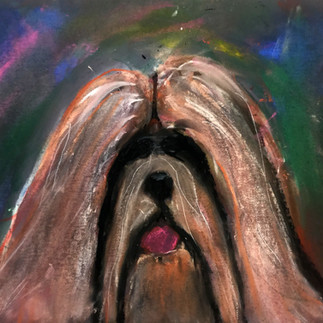Great Expectations
- Ann Russell
- Mar 18, 2024
- 4 min read

Twenty years ago, when I first started out on my own as a teaching artist, one of my first adult students was a woman who later admitted to me that when she first rocked up to one of my classes she was mildly terrified. You see, her previous experience in art classes had left her feeling attacked, judged and hugely discouraged. She was relieved to discover that I was not the kind of teacher who would snatch the brush away from her and fix her "mistakes" or even show her how to do it "properly".
That's because I work according to some firmly held beliefs regarding creativity and the making of art. For instance, the process is infinitely more important than the product. Our society in general doesn't support this idea, even when it says it does. People think that every single painting is supposed to be technically and aesthetically brilliant. If it isn't there must be something wrong with them (or me as their teacher). That's in keeping with the erroneous cultural idea that you are either creative or you are not. If that were true, creativity in whatever form it takes, would be the only instance of human activity where getting better at it didn't depend on practice.
Even if you are athletic, you don't walk onto the soccer field for the very first time expecting to be picked to play for Australia. Of course you may have a particular innate ability, but you have to put in the hard work to become excellent. Even then, you will have good days and bad days, and games where you couldn't really perform despite your hard work. What makes you great is your ability to stick at it, overcome obstacles and put in the hard work. Expecting to join the Matilda's without putting in the hard work is kind of insulting to them (because they have) and an unrealistic expectation for you, a great way to feel discouraged and defeated. The same applies to art.

And, if you are afraid of making mistakes, you won't ever be prepared to try things out, explore and experiment to see what happens. Your work will be rigid due to your need to control, rather than play and enjoy the process. As I tell students, every single artist you can think of who has reached a degree of success, has put in the miles and has been prepared to make mistakes, experiment and explore. You have to be prepared to make "bad" art (whatever that is) in order to make something good. We think of the work that might be hanging on gallery walls as a professional artist's entire output. But it won't be. They too will have unfinished, rejected, discarded works that in themselves are not anything to write home about, but have played a crucial part in the development of their work overall.
I also don't think there should be rules that we rigidly follow when we make art. Sure, there are tips and tricks we can learn, but there is no correct way to use a particular medium or create art according to a particular genre. I really don't get people's adherence to rules when it comes to making art. No artist who has ever achieved anything in the art world has done so by doing what was expected. Van Gogh, Monet, Kahlo...any famous artist you can think of resisted the conventional wisdom about making art. Beyond that, thanks to technology, the lines are being continually blurred in terms of media, in particular. For example, you can now get oil paints you mix with water, canvases made for watercolour and every colour you can imagine available in a tube. So if you hold to the idea that you can only use watercolour in a particular way, for example, you are going to get left behind in terms of creativity.
All of that is the reason why I love what is generally referred to as "Outsider Art" - art work produced by people who are largely untrained and often experiencing a disability or institutionalised in places like prisons, mental health or medical hospitals. They have never learnt the "rules" and make art combining whatever media they can get their hands on to express whatever is going on in their inner most selves.


Kids too are much more prepared to be creative. Unlike adults they often haven't learnt all the "rules" that adults have become dependent on. So, they will ask if they can make their background pink instead of blue, can they make their flowers in the shape of a heart, turn the drawing of a horse into a Unicorn or if they can put a koala in the tree along with the African birds they are working on. I have learnt that my answer should always be "yes, of course, it's your art" rather than, "no, African birds and koalas wouldn't live in the same trees". The results may be a bit odd, wonky or just weird, but they have done the most important thing to me...practiced creativity.
So forget the rules and enter into the flow of creativity. You will have fun and you might just find that the "product" has a life and vitality that was previously lacking. Make your great expectations about developing your creativity, not about creating something worthy of the Louvre.
















Comments